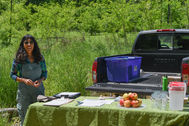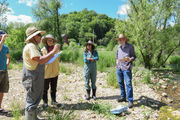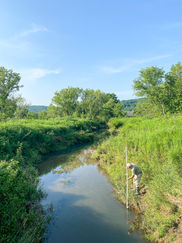We protect what communities depend upon.
CSP organizes to protect the resources we all depend upon, approaching this work not as battles to be won, but as opportunities for communities to come together around issues that impact us all, as good work over which to put our heads together for lasting solutions.
CSP works to support local planning processes so that communities can define the futures they want and encourage the types of development they wish to see. Much of CSP's Protect work is in direct response to un-invited, industrial-scale operations that threaten local quality of life in multiple ways: by depleting shared natural resources, polluting water & air, exporting wealth away from our local economy, lowering property values, and putting our traditional small and
medium-scale operations out of business.
Protecting Against Pollution & Extraction
CSP keeps a close eye on un-invited industrial-scale developments that may not be a good fit with our fragile karst geology. We facilitate clear and open dialogue among all stakeholders.
Our approaches:
-
Watchdog the siting of polluting industries in our communities, monitor those already here.
-
Alert residents and landowners to public processes that could impact community health and natural resources.
-
Support grassroots community efforts, empowering those most impacted to participate productively in decision-making processes.
-
Work with experts, media, and government, to facilitate bottom-up communication to inform policy decisions.
** October 2025 Special Report **
The Proposed Gruber Hog Operations: Some Context
In July 2025 Crawford County received two permit applications for two new large hog operations. In the applications the two operations are named Gruber Livestock North and Gruber Livestock South, they are of identical design, located neighboring each other, and list two separate owners who live in the same Illinois county just south of Chicago and who appear to work at the same culinary sourcing company.
Each of the two permit applications is for 999.6 animal units (AU). This is notable because 1,000 AU is the threshold for more stringent state oversight from the Wisconsin Department of Natural Resources (DNR). Operations between 500-999 AU are overseen by the county.
Industrial hog operations tend to locate in clusters, with some producing piglets, others growing the hogs to slaughter-weight, etc. The Gruber applications are for "Gilt Development Units," making it highly likely that the Gruber operations will serve as a beacon to attract additional industrial hog operations. Many people in Crawford County are concerned that our local livestock ordinances are currently inadequate to protect our communities from the risks of industrial scale livestock operations. This document explains some of the concerns and some actions that can be taken.
*Note: The units of measurement in this document are acres and animal units (AU).
- To visualize an acre, it is roughly the size of an NFL football field without the endzones. One square mile contains 640 square acres.
- An animal unit (AU) is a standard agricultural unit of measure, 1 AU = 1000 pounds of live animal. For example 2 heifers each weighing 500 pounds would total 1 AU. A 1400# dairy cow would be 1.4 AU, and a 400# hog would be 0.4 AU.
1. Animal/Manure Concentration
Manure is a natural part of healthy ecosystems. However, the concentration of animals and the amount of land their manure is spread over is on a very different scale with industrial operations. Here are some comparisons of density:
-
Wild Deer: The natural deer population in Crawford County averages 0.0098 AU per acre.
-
Beef & Dairy Grazing: Managed grazing operations are often stocked around 0.7 AU per acre.
-
Industrial Livestock Operations: This system confines livestock at high density, collects manure in a slurry pit, and spreads the slurry over nearby fields. The combined Gruber operations propose a confinement density of 2073.8 AU/acre, with manure spread at a density equivalent of 4.5 AU per acre.
2. Why All Manure Isn't "Good" Manure
Manure can be a valuable fertilizer. However, the waste from an industrial confinement operation is fundamentally different from traditional farm manure.
-
Beef Grazing Manure: On a grazing operation, manure is solid and deposited directly onto the pasture by the animals. This natural waste, rich in organic matter, attracts a diverse range of soil life, including dung beetles and earthworms. These organisms quickly break down and integrate the waste into the soil, building soil health over time.
-
Dairy Barn Manure: On a traditional dairy farm, manure and bedding are stored in a pile and then spread as a solid, nutrient-rich fertilizer. Because it is solid, it is less prone to runoff and can be worked into the soil, where it contributes to organic matter and soil structure.
-
Industrial Livestock Slurry: The waste from industrial operations is managed as a liquid. The manure and urine, along with other wastewater, are collected in a lined pit as a slurry, without the natural decomposing agents found in pasture soil or a compost pile. The slurry can contain harmful substances like barn cleaners, hormones, and antibiotic-resistant pathogens.
Slurry from industrial confinement operations is a potential pollutant because of its immense volume, anaerobic decomposition, and chemical makeup. It is a liquid industrial waste product, more akin to sewage than the valuable fertilizer most of us are accustomed to.
3. A "City of Hogs"
The proposed Gruber operations are not traditional farms. The combined operations will house 1999.2 animal units (AU), equivalent to the weight of 12,103 people, roughly the population of Platteville, WI (including students).
The Gruber operations are a "city of hogs" that will be built on a ridge of rural Crawford County, without a sewage treatment system.
4. The Volume and Destination of the Slurry
The combined Gruber permit applications propose to generate and spread 2,216,562 gallons of manure slurry each year, enough to fill 382 milk trucks, a line of trucks 5 miles long.
This slurry will be spread on 446 acres of cropland, meaning that each acre will receive 4,965 gallons of slurry each year. Slurry is typically spread only 1-2x/year, overloading the soil with large volumes of liquid all at once.
Slurry is very prone to runoff into streams and groundwater.
5. Karst Geology: A Direct Path to Your Drinking Water
Crawford County sits on karst geology, where the underlying bedrock is made of soluble limestone and dolomite. Over thousands of years, water has dissolved this rock, creating a vast underground network of caves, sinkholes, and fissures.
This unique geology means that what happens on the surface can quickly impact the groundwater below. When rain and melted snow move across the surface, they can pick up slurry runoff and carry it directly through sinkholes and fissures into groundwater, bypassing the natural filtration process of soil. Once a contaminant enters groundwater it can travel great distances through the interconnected network of underground streams.
This is not a theoretical risk. Fifteen years of stream-testing near another industrial hog operation in Crawford County has recorded E.coli and Total Phosphorus both regularly above levels safe for recreational contact, as well as detecting MRSA (Methicillin Resistant Staphylococcus aureus) associated with industrial livestock operations.
Because of our karst geology, the water flowing through Crawford County is uniquely interconnected. Because nearly all Crawford County residents rely on groundwater wells for their drinking water, the risk of contamination from slurry, and threat to the surrounding community's health, is very real.
image: Runkel and others, 2003
https://home.wgnhs.wisc.edu/wisconsin-geology/karst-sinkholes/
6. We Can Protect Our Water
Operations like Gruber are not overseen by the state, they are the responsibility of local governments. Counties and townships can manage this responsibility by working to craft standards that fit their unique communities and landscapes, written as local operations ordinances. In Crawford County this work has never been completed, and so our county has very little legal basis on which to decline or impose standards on an industrial livestock permit. Once a permit is granted it is generally “grandfathered in” to the existing level of oversight, even if an ordinance were to be adopted in the future.
In 2019, the Crawford County Board passed a year-long moratorium on new industrial livestock permits in order to review and update County standards as necessary. A special committee was formed, made up of county Conservation and Health Department staff, members of the County Board, and representation from conservation and farming groups. They produced a 126 page report that reviewed vulnerabilities in local agriculture, natural resources, economy, public health, community concerns, and regulatory gaps. The report outlined recommendations, including operations ordinances. And then things stalled and COVID hit.
The Gruber permit applications are a reminder that Crawford County has unfinished work in adopting industrial livestock operations ordinances.
Your voice makes a difference in supporting our county officials to complete this work. Crawford County is accepting public comments on the Gruber Livestock permit applications until Tuesday, October 14, 2025. Send comments to County Conservationist Dave Troester at dtroester@co.crawford.wi.gov, or attend the public hearing on 10/14, from 12-2p at the Crawford County Administration Building, 225 N Beaumont Rd, Prairie du Chien.


Water Quality Monitoring Program Manager:
Omaru Heras
oheras@crawfordstewardship.org
Reports:
-
Wisconsin WAV database (includes data collected by CSP)
Water Quality Monitoring
Since 2008 CSP's award-winning Water Quality Monitoring project has been training and coordinating citizen-scientist volunteers in annual monitoring of 13 streams & springs, with an emphasis on sites of concern. Test results are filed in the Wisconsin state database, and thanks to our (your!) work several local streams have been officially prioritized for care.
Our approaches:
-
Engaging citizen scientists in collecting valuable streamwater data while immersing themselves in nature and observing first-hand the changes in our watersheds.
-
Documenting the effects of industrial-scale operations on downstream water quality.
-
Making data available to decision makers, to enable well-informed land-use and governance decisions.
Our ongoing work includes:
-
Facilitating at least one Water Action Volunteers (WI DNR program and UW-Extension) Water Quality Monitoring Training in April/May of each year.
-
Coordinating:
-
Active volunteers at 13 sites (streams and springs) of specific concern in Crawford county, ensuring data logging.
-
High school students at a site next to North Crawford District School in an educational collaboration.
-
Volunteers at two sites being intermittently monitored for Microplastics.
-
-
Supporting citizen monitors in neighboring counties through coordination, logistical help, and guidance towards available resources.
-
🦺 website under construction 🦺 [...add in testing, working with labs, analyzing/publishing results, and reporting/recording to agencies.]


Significant Results:
-
2008 – 2021: Over 100 volunteers have been trained in alliance with the WAV Program (WI DNR and UW-Extension) & Valley Stewardship Network, and the 2017 Water Rangers of the Socially Responsible Agriculture Project. There are 30 current active volunteers in 8 sites of concern and other local sites.
-
2013: Crawford Stewardship Project (CSP) received the Citizen-based Monitoring Award for Group Effort at the Citizen-based Monitoring Conference in Wisconsin Rapids held by UW-Extension and the WI DNR.
-
2016: WI WAV Stream Monitoring Award in the “Adult Volunteer” category won by CSP volunteers Ellen Brooks (also a CSP Board member) & Dave Hackett.
-
2018: WI WAV Stream Monitoring Award in the “Adult Volunteer” category won by CSP volunteers Debbie & Bill Hiller.
-
Due to the constant submission of more than 10 years of data, Sites # 10032119, # 10044917 and #10052569 were placed on the impaired waters lists in 2018, 2020 and 2022, respectively.
-
2022: The WI WAV Stream Monitoring Award in the “Adult Volunteer” category was given to CSP volunteers Kathy (who also was a CSP Board member and staff) & Paul Byrne.
-
2023-2024: 15 volunteers passionately monitoring 13 sites (8 of specific concern, 3 requested by the DNR, and one for young students).
What you can do:
-
The spring trainings consist of three stream monitoring levels available to people who want to join existing sites of concern and tributaries of the WI and Kickapoo Rivers in Crawford Co. Monitoring is done once a month for an hour or so from May till October, and is a great and fun way to help out while getting outside!
-
Level 1 (first year): teaches entry level volunteers how to monitor dissolved oxygen, temperature, transparency, streamflow, habitat assessment, and macroinvertebrates (biotic index), using Water Action Volunteers (WAV) methods. An excellent way for everyone to participate in citizen science and to get to know their local waters better. No previous experience necessary!
-
Level 2: brings volunteers to the next level of independence, and involves using more sophisticated devices to test for dissolved oxygen, pH and temperature.
-
Level 3: involves research and special projects, such as Total Phosphorus testing. We also include and sample for E. coli, total coliform, background bacteria, fungi, Staphylococcus sp & aureus, MRSA (Methicillin Resistant Staphylococcus aureus), and DNA marker for specific feces sources. State and local labs are pillars in this process.
-
-
The data collected gives us a baseline of stream health, which is critical for determining how various types of land use affects our watershed. Every result is carefully recorded, shared publicly, and submitted to the Department of Natural Resources (DNR), Extension University of WI-Madison, and the Environmental Protection Agency (EPA).





















